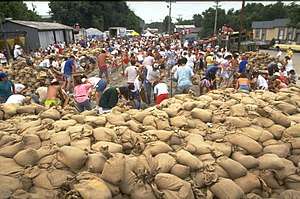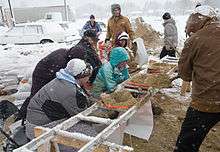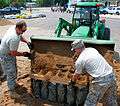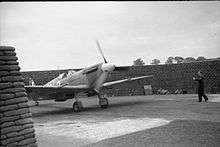Sandbag
A sandbag or dirtbag is a bag or sack made of hessian (burlap), polypropylene or other sturdy materials that is filled with sand or soil and used for such purposes as flood control, military fortification in trenches and bunkers, shielding glass windows in war zones, ballast, counterweight, and in other applications requiring mobile fortification, such as adding improvised additional protection to armoured vehicles or tanks.


The advantages are that the bags and sand are inexpensive. When empty, the bags are compact and lightweight for easy storage and transportation. They can be brought to a site empty and filled with local sand or soil. Disadvantages are that filling bags is labor-intensive. Without proper training, sandbag walls can be constructed improperly causing them to fail at a lower height than expected, when used in flood-control purposes. They can degrade prematurely in the sun and elements once deployed. They can also become contaminated by sewage in flood waters making them difficult to deal with after flood waters recede.[1] In a military context, improvised up-armouring of tanks or armoured personnel carriers with sandbags is not effective against cannons (though it may offer protection against some small arms).
Usage

Flood control
Properly stacked sandbags[2] are an effective deterrent against damaging flood waters. Sandbags can be used to build levees, barricades, dikes and berms to limit erosion from flooding. Sandbags can also be used to fortify existing flood control structures and limit the effects of sand boils. Sandbag structures do not prevent water seepage and therefore should be built with the central purpose of diverting flood water around or away from buildings.
Properly filled sandbags for flood control are filled 1/2 to 2/3 full with clean washed sand. In an emergency, if clean sand is in limited supply, gravel or dirt can also be used with less effective end results. When filled sandbags are stacked or laid in place, the contents need to settle flat to the ground. Sandbags filled over 2/3 full will not form an adequate seal to the ground or structure. Likewise sandbags filled under 1/2 will generally also form an inadequate seal to the ground when placed.
The best practices for filling sandbags require a three-person team. One team member will crouch down and hold open the bag to form a collar opening. The second team member places the tip of a pointed shovel with sand into the opened sandbag. A square shovel is not recommended as the blade of the shovel will not fit into the sandbag when filling. The third team member will transport and stockpile the filled sandbags.
Properly placed sandbags will be set lengthwise and parallel to the water flow with the folded or open end of the sandbag facing upstream. All loose debris should be removed from the placement surface and the lowest areas are the first spots to be filled in with sandbags. Each bag must be set consecutively with the tightly packed bottom slightly overlapping the previously placed sandbag. Subsequent layers of bags should be offset by 1/2 the length of a sandbag to eliminate voids and improve the wall seal. Each placed bag should be tamped and flattened to improve the seal.
The two primary methods for stacking sandbags to build flood control structures are the (1) Single Stack placement, and; (2) Pyramid Placement Method.[3]
Fortification
The military uses sandbags for field fortifications and as a temporary measure to protect civilian structures. Because burlap and sand are inexpensive, large protective barriers can be erected cheaply. The friction created by moving soil or sand grains and tiny air gaps makes sandbags an efficient dissipator of explosive blast.[4] The most common sizes for sandbags are 14 by 26 inches (36 by 66 cm) to 17 by 32 inches (43 by 81 cm).[5][6] These dimensions, and the weight of sand a bag this size can hold, allow for the construction of an interlocking wall like brickwork.
Individual filled bags are not too heavy to lift and move into place. They may be laid in excavated defences as revetment, or as free-standing walls above ground where excavations are impractical. As plain burlap sandbags deteriorate fairly quickly, sandbag structures meant to remain in place for a long time may be painted with a portland cement slurry to reduce the effects of rot and abrasion. Cotton ducking sandbags last considerably longer than burlap and are hence preferable for long-term use. However, the vast majority of sandbags used by modern military and for flood prevention are made of circular woven polypropylene. Some of the World War I memorial trenches were rebuilt with concrete sandbags after the First World War—although criticized as looking unnatural, they have lasted well. During World War II in Great Britain, some aircraft revetments and pillboxes were made from concrete filled sandbags, again these have lasted well.
Sandbags have been used since at least the late 18th century. For example, British loyalists used sandbag and log fortifications in the 1781 Siege of Ninety-Six during the American Revolutionary War. Nathanael Greene was familiar enough with the fortification technique to equip his troops with hooks to pull down the sandbag and log walls when they stormed the Star Redoubt in Ninety Six, South Carolina.[7] Sandbags have traditionally been filled manually using shovels. Since the 1990s, machine filling has become more common, allowing the work to be done more quickly and efficiently.
Bulk bags
Bulk bags, also known as big bags, are much larger than traditional sandbags. Moving a bag of this size typically requires a forklift truck. Thailand utilized bulk bags filled with sand to erect temporary walls to protect against the 2011 Thailand floods.
Other uses

Sandbags are also used for disposable ballast in gas balloons, and as counterweights for theatre sets. Some temporary construction signs or advertising signs are held in place and secured against being blown over with sandbags.
During World War II, sandbags were also used as extemporized "soft armor" on American tanks, with the goal of protecting the tanks from German anti-tank rounds,[8] but they were largely ineffective.
Sandbags can also be carried within vehicles to provide improved traction during inclement weather (typically stored above the drive wheels where the increased weight improves traction). If ever stuck, sand can be removed and placed directly onto the slippery surface thereby providing greatly improved traction. Sandbags are also used by off-road enthusiasts instead of sand plates or sand ladders to assist the vehicle to get traction and momentum after being stuck in soft sand. The same sandbags can be used to bridge deep holes or ditches. Apart from being very light and taking very little space (when empty), the sandbags are a much cheaper option than any of the other options (sand plates, sand ladders, multipurpose bags, etc.).
Sandbags are often used to temporarily stabilize soil from erosion, such as oceanfront structures whose foundations have been undermined by heavy waves. Sandbags are also used in earthbag construction to make inexpensive, environmentally sustainable homes. In addition, sandbags are often used when shooting a long gun, specifically a rifle or sniper rifle, from a rest, as it provides support for the weapon, allowing for less movement during shooting.
Sandbags of various sizes and weights can be used for exercise or resistance training.[9]
Sand Bags for safety in film, video and theatrical production. Sand bags are often used as easily portable weight to lower the center of gravity of a Light stand or a C-Stand where heavy items are placed at the top of a high stand often having a small base. Shot bags are another type of flexible weight used for the same purpose.
Figurative use
In games and various kinds of adversarial settings, the term sandbagging refers to the practice of purposely placing oneself in a weaker position so as to give the deceptive impression that one is less skilled than one truly is.
In slang
The word can also refer to a simple weapon consisting of a small bag filled with sand for use as a cudgel typically by criminals, or to the act of striking a person on the head with such a weapon.[10] This usage is obsolescent in normal speech, appearing mainly in legal codes. However the verb form is extended metaphorically in several slang expressions.
Gallery
 Manual filling of sandbags.
Manual filling of sandbags.%2C_Naval_Station_Great_Lakes%2C_upper_left%2C_helps_speed_up_the_sand_bagging_process.jpg) Improvised method of sandbag filling.
Improvised method of sandbag filling. Sandbags being filled using improvised methods, lumber and traffic cones as chutes, Iowa City, Iowa, 2008.
Sandbags being filled using improvised methods, lumber and traffic cones as chutes, Iowa City, Iowa, 2008. Manual filling of sandbags from a hopper or silo
Manual filling of sandbags from a hopper or silo Manual filling with a conveyor belt and a 12 direction sandbag filler called "The Sandbagger" capable of filling over 5,000 sandbags an hour.[11]
Manual filling with a conveyor belt and a 12 direction sandbag filler called "The Sandbagger" capable of filling over 5,000 sandbags an hour.[11] Filling multiple sandbags with a front-end loader.
Filling multiple sandbags with a front-end loader.- A German, roller container mounted, sandbag filling machine
_officer_carriers_empty_sandbags_during_a_construction_project_to_build_an_ALP_checkpoint_in_Helmand_province%2C_Afghanistan%2C_March_30%2C_2013_130330-M-BO337-031.jpg) An Afghan Local Police officer carries a bundle of empty sandbags during a checkpoint construction project
An Afghan Local Police officer carries a bundle of empty sandbags during a checkpoint construction project A sandbag levee in North Dakota
A sandbag levee in North Dakota- A sandbag wall to limit erosion, wave damage and flooding
 A defensive fighting position made with sandbags
A defensive fighting position made with sandbags Sandbagged aircraft revetment
Sandbagged aircraft revetment World War II aircraft revetments made of concrete filled sandbags, as seen decades later in 2009.
World War II aircraft revetments made of concrete filled sandbags, as seen decades later in 2009.
See also
| Wikimedia Commons has media related to Sandbags. |
- Hesco bastion
- Sandbagging
- Metalith, brand name/manufacturer of an alternative flood control technology
- HydroSack, brand name of an alternative sandless sandbag for flood control
References
- Leibenluft, Jacob (2008-06-20). "The 25-Cent Flood Protection Device". Slate.com.
- Moellman, Mark (2017). Sandbags for Flood Control - 8 Things you Need To Know
- "US Army Corps of Engineers, Northwest Division" (PDF).
- War Office. Military Training Pamphlet No 30, Part V: Protective Works. 1941. p. 39 specifies 20 inches (510 mm) of sand in bags as proof against armour piercing bullets and bomb fragments.
- Kim Williamson. How Sandbags Work. Answers.com.
- Kelly Hart. Type of Earthbags to Use. EarthbagBuilding.com.
- Lanning, Michael Lee (2009). The American Revolution 100: The Battles, People, and Events of the American War for Independence, Ranked by Their Significance. Sourcebooks, Inc. p. 319. ISBN 9781402247309.
- Hunnicut, R.P. "Sherman: A History of the American Medium Tank" ISBN 0-89141-080-5
- "Add Sandbag Training to Your Workout". Muscle & Fitness. May 2011.
- "Sandbag". Online Etymology Dictionary. Retrieved 2014-07-05.
- White, Patrick (2009-04-10). "79 year old ex Quarry Manager invents Sandbagger". Aggregateresearch.com and The Globe and Mail.
External links
- California Department of Water Resources - Flood Fighting at home, How to fill and place sandbags (PDF)
- California Department of Water Resources and the California Conservation Corps - Flood fighting Methods (PDF)
- US Army Corps of Engineers Sandbagging pamphlet (PDF)
- FEMA - Flood Response manual for Community Emergency Response Teams, including sandbagging techniques (PDF)
- US OSHA recommendations for safely Filling, Moving and Placing Sandbags During Flooding Disasters